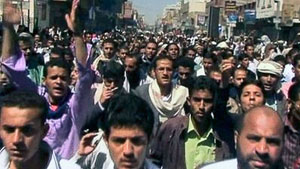Yemen’s people demand ouster of ruler
By
LeiLani Dowell
Published Feb 26, 2011 10:40 AM
Protests continued throughout the country of Yemen on Feb. 21 to demand the
ouster of President Ali Abdullah Saleh. The demonstrations, which began during
the time of the uprising in Tunisia and gained traction with recent events in
Egypt, have increased in scope and intensity in the past 12 days.
Since Feb. 20, thousands of people have set up tents and occupied the two city
blocks in front of Sana’a University, saying that they will not leave
until Saleh leaves office. The Toronto Star described the scene: “In the
early afternoon, 500 demonstrators danced, sang and shouted speeches. A line of
self-appointed young guards, flanked by a row of motorcycles, blocked the
streets leading to the group, and those wanting to enter were hastily searched
for weapons.” (Feb. 21) Demonstrators at the university have renamed the
area “Tahrir Square,” in homage to the focal point of protests in
Egypt that brought down Egyptian President Hosni Mubarak.
The Feb. 21 Guardian (Britain) reports that thousands of people also held
sit-ins in the cities of Ibb and Taiz. In the port city of Aden, demonstrators
torched a local government building. The Yemen Post reports that banks and
other large businesses have closed in response to the spreading protests. (Feb.
20)
Like the former president of Egypt, Saleh has been in power in Yemen for more
than 30 years, since 1978. Protesters have rejected Saleh’s announcement,
made at the beginning of the protests, that he would not seek re-election in
the 2013 elections — a strategy that was also attempted by Mubarak. In
Yemen, the people are particularly loath to believe Saleh’s statement,
since he made similar pledges before the elections there in 1999 and 2006.
As in Egypt, protesters in Yemen have hit the streets in the face of massive
unemployment, poverty and repression. The Washington Post notes that the daily
protests have been “fueled largely by students and human rights activists
but increasingly attracting lawyers, union workers and ordinary
laborers.” (Feb. 17)
Twelve people have been killed, including a teenager who was shot by soldiers
after he and other youth threw stones at a patrol on Feb. 21. Four others were
injured in the incident. Yemen analyst Jane Novak reported that medics who
attempted to revive the wounded were shot at by police. In the city of Taiz,
two people were killed Feb. 18 after a hand grenade was thrown into a crowd of
protesters. (Press TV, Feb. 20) Anti-Saleh protesters have also clashed with
administration loyalists, who chased them in front of the university with
batons and daggers.
Washington provides millions in military and other aid to the Saleh
administration, which has been a partner to the U.S. in the so-called
“war on terror.” Both U.S. special operations forces and the CIA
operate in the region under the guise of fighting the group, al-Qaida in the
Arabian Peninsula, which is allegedly located in an oil-rich area of the south.
The U.S. has bombed the region as part of that war.
The country has a long history of struggle. After ousting British colonialists
in 1967, Yemenis in the south of the country set up the People’s
Democratic Republic of Yemen, which sought to build a socialist state and
aligned itself with the Soviet Union, China and Cuba. After the south reunited
with the north in 1990, following the collapse of the socialist camp, the
country was destabilized by the expulsion of a half million Yemenis from
neighboring Saudi Arabia in retaliation for Yemen’s refusal to back the
U.S.-led war on Iraq.
Articles copyright 1995-2012 Workers World.
Verbatim copying and distribution of this entire article is permitted in any medium without royalty provided this notice is preserved.
Workers World, 55 W. 17 St., NY, NY 10011
Email:
[email protected]
Subscribe
[email protected]
Support independent news
DONATE


